This page contains affiliate links. Please read our disclosure for more info.
TeamLab Planets Tokyo is an interactive digital art museum that uses lights, projections, water, and sounds in creative ways.
It’s an immersive, surprising experience that dissolves the boundaries between the viewer and the art.
We loved TeamLab Borderless (which I compare to Planets below) and enjoyed TeamLab Planets just as much.
Some people say this popular attraction is overrated, but we think it’s unique and magical.
In this TeamLab Planets review, I share what to expect at the museum, practical details like how to get tickets (they do sell out), and our best TeamLab Planets tips (including what to wear to manage the water sections).
Contents
- TeamLab Planets Location
- TeamLab Planets Hours
- Best Time to Visit TeamLab Planets
- TeamLab Planets Tickets
- How Long to Visit TeamLab Planets
- What to Wear to TeamLab Planets
- What to Expect at TeamLab Planets
- What Are the Best Areas in TeamLab Planets?
- UZU Ramen
- How to Get to TeamLab Planets
- What to Visit Near TeamLab Planets
- TeamLab Planets vs Borderless
- Is TeamLab Planets Worth It?
- More Japan Posts
TeamLab Planets Location
TeamLab Planets is located in Toyosu, a manmade island and neighbourhood of Tokyo. It’s a little out of the way from central Tokyo, but it can be reached by public transport in about 45 minutes from Shinjuku and Shibuya.
See below for how to get there.
You can see the TeamLab Planets location on Google Maps.
TeamLab Planets Hours
TeamLab Planets’ opening hours and closing days vary, so it’s best to check the TeamLab website.
It is usually open from 9am – 10pm (with UZU ramen open 11am – 8.30pm).
TeamLab Planets is currently due to close at the end of 2027, but there’s always the chance it will be extended (as it has in the past).
Best Time to Visit TeamLab Planets
The best time to visit TeamLab Planets is at opening on a weekday.
We loved being one of the first people to enter. It was noticeably quieter at 9am than at 10am.
If that’s not possible, I would choose two hours before closing (and eat ramen before your visit).
The middle of the day is busiest, and you should avoid weekends and public holidays if you can.
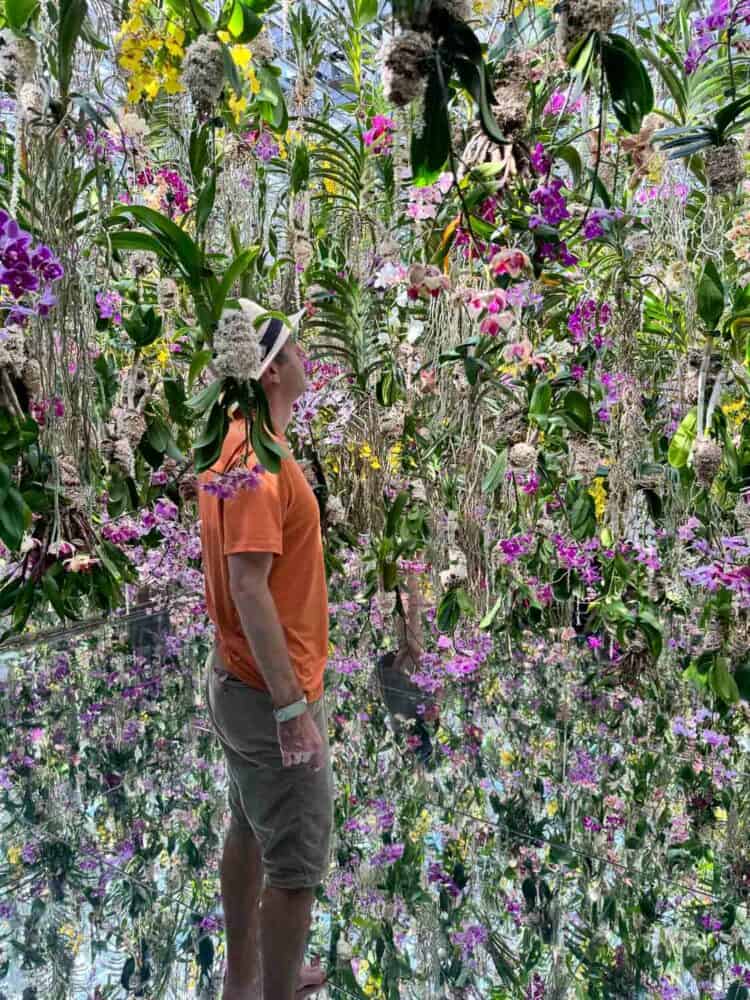
TeamLab Planets Tickets
TeamLab Planets ticket costs vary depending on the date and usually range from around 4000 yen ($27) to 5000 yen ($33) for adults.
You must book in advance for a specific time slot.
Tickets go on sale about three months in advance. While you might be able to get an afternoon slot if you book last minute, if you want the first slot, I recommend booking two months ahead especially at peak times like April.
You can book on the TeamLab website, or if you are already booking other tours and tickets, it might be easier to use Klook or Get Your Guide. They often have different availability so check both.
How Long to Visit TeamLab Planets
For our 9am slot, we arrived at 8.40am and left at 11.30am, so we were there for about three hours, including queuing to get in and eating at UZU Ramen.
It took us an hour to walk around the whole exhibition (Water and Garden) the first time, and then we did another loop around Water, which took 30 minutes.
In January 2025, three new areas and a cafe opened, so you’ll likely need to add an extra hour to that estimate. Allowing half a day should be fine.
See our guide to fun things to do in Tokyo for more ideas in the city.
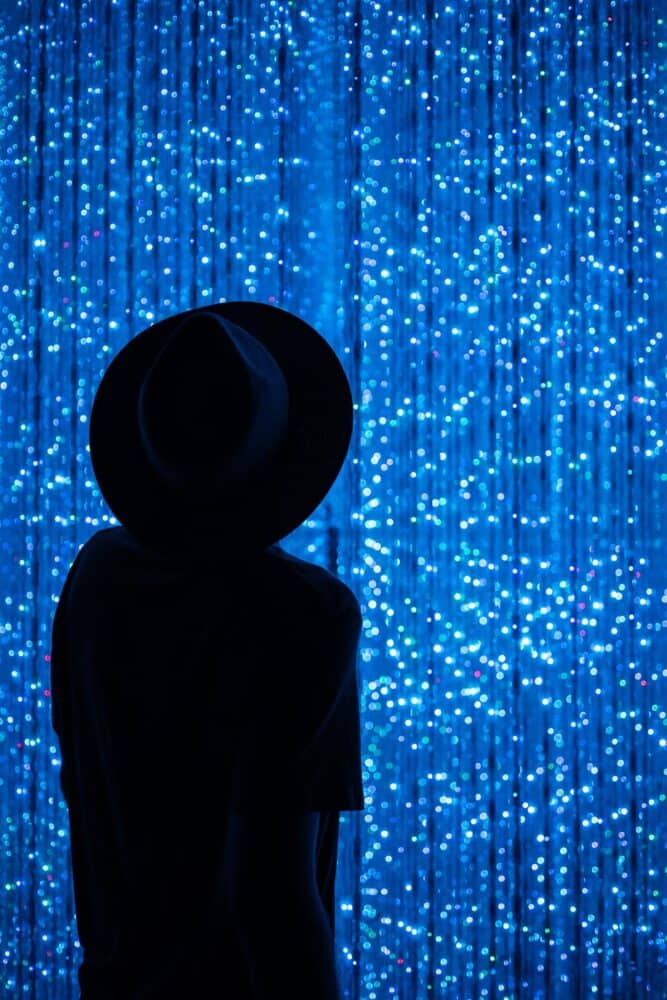
What to Wear to TeamLab Planets
TeamLab Planets is a mostly shoeless attraction—you must go around the Water and Garden areas barefoot (no socks). It’s easier to wear shoes that can be quickly slipped off.
You will need shoes for the new Forest play area. No heels or sandals are allowed (but you can borrow free shoes if necessary).
You will be walking through water in several sections. The water level comes about halfway up an adult’s shin (depending on your height). It’s best to be prepared to get wet from the knees down.
It’s easiest to wear shorts to TeamLab Planets (which is what we did) or at least trousers that you can easily roll up above the knee (skinny jeans are not ideal!).
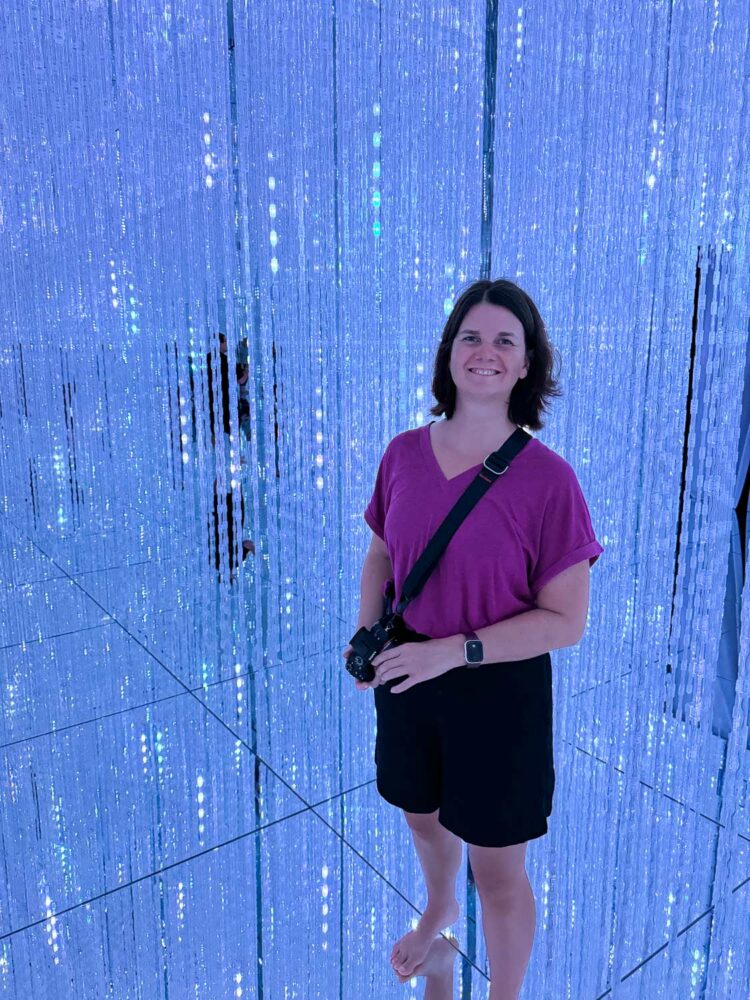
You can also borrow shorts at TeamLab, but this would slow you down on arrival (important for the first slot).
We saw plenty of people wearing skirts, but the floors are mirrored in some areas, so your underwear may be visible—wearing shorts under a skirt is a good idea.
Lockers are provided when you arrive; you must leave your shoes, bags, and jackets in them.
The only things you can carry into the exhibition are cameras and phones. Tripods and selfie sticks are not allowed.
If you will be taking your phone with you, you might want to wear something with pockets so you don’t have to carry it in your hands the whole time. A clear lanyard is also acceptable (fanny packs/waist bags are not).
I had my camera on a strap, which made it easy to carry around. Light levels are low, so put your fastest lens on your camera (you can’t bring spare lenses in).
Towels are provided to dry off your feet once you leave the wet areas.
If you are visiting with small children, it’s best to bring a spare set of clothes in case they get soaked.
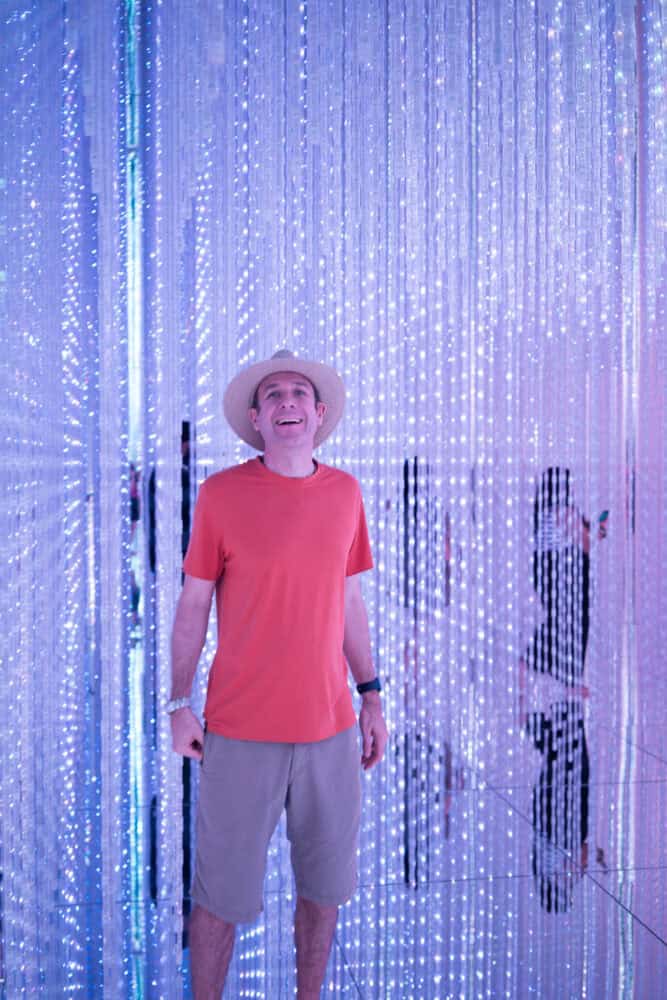
What to Expect at TeamLab Planets
On Arrival
It’s worth arriving at TeamLab Planets 15-30 minutes before your allocated entrance time, as there will be a queue to get in.
As we’d booked the first 9am slot, we arrived at 8.40am and had to wait outside the complex on the street. There were about 20 people in front of us. By 9am the queue was much longer.
At 9am we were let into the grounds and joined the official queue for the building. There’s a sign that says which time slots are allowed to queue.
If you are too early to join the queue, there’s an outside area with seating, restrooms, and water vending machines.
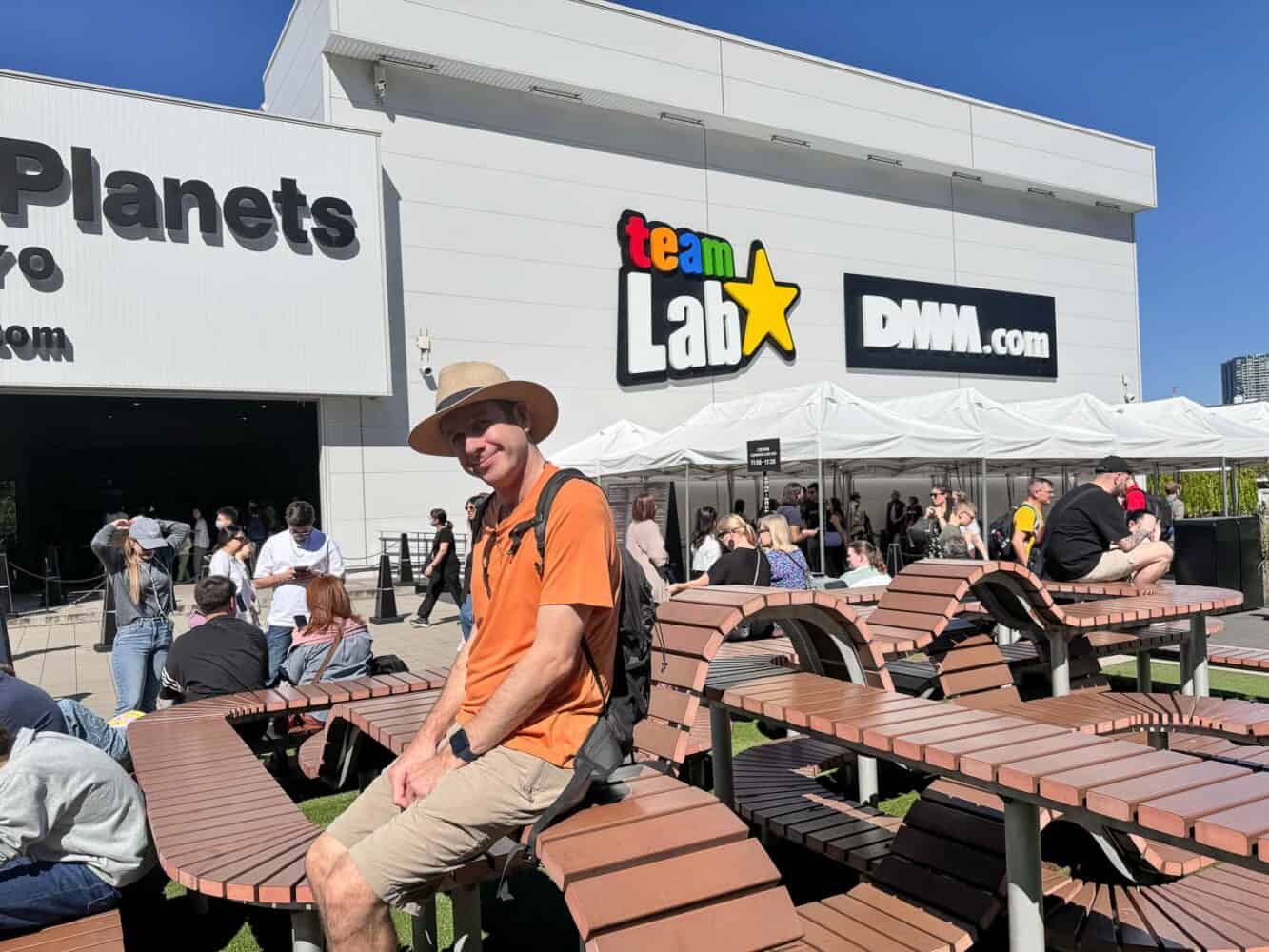
There’s also a fiery tower-like artwork, Universe of Fire Particles Falling from the Sky, that interacts with an app. We looked at this after our visit.
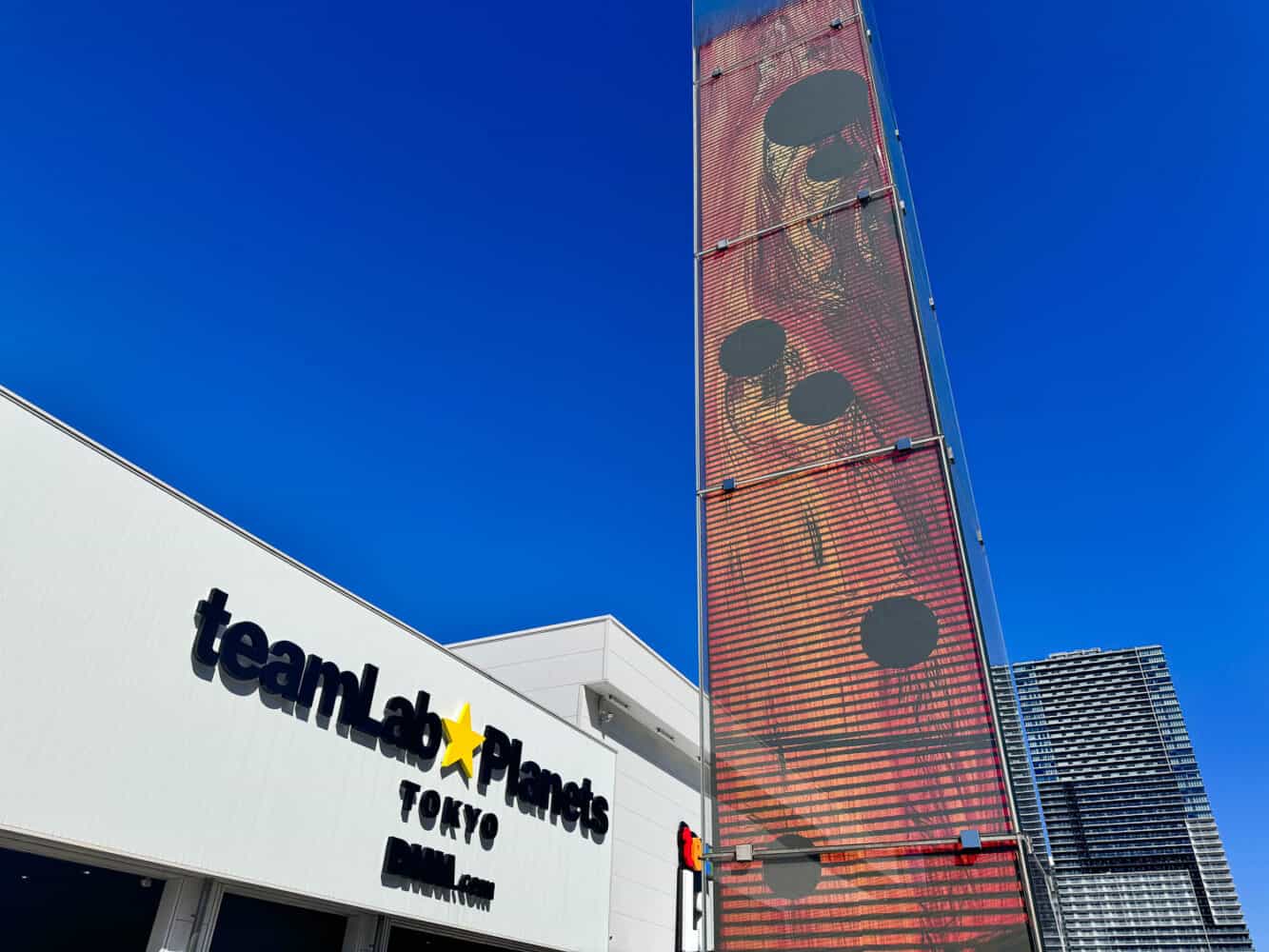
We didn’t use the facilities as we didn’t want to lose the advantage of arriving early.
We were let in with the first group at 9.05am and shown a short video that explained you’ll need to be barefoot, etc.
Then the doors open into the locker room. You must take off your shoes before you enter this area.
There are many rows of lockers. We headed straight to the furthest aisle, which is quieter and closer to the exhibition entrance.
We already had our stuff prepared, so we were able to put our bags and shoes in the locker quickly. The lockers are free and use a key that you keep with you.
There are restrooms in the changing area, but I skipped them for now to save time.
As we were fast to put our stuff away, there were only five people ahead of us when we entered the exhibit.
While everyone didn’t take long to catch up, we enjoyed having those quiet moments at the start.
There were two areas at TeamLab Planets on our visit (another area called Forest opened in 2025). You start by going right to the Water route, then return to the locker area (where you can access your stuff/ use the restrooms, etc.) before going left to follow the Garden route.
Note that there are a few stairs; people in wheelchairs can take an alternative route.
Water Area
I felt a little stressed after a morning travelling on rush hour trains and queuing, but it didn’t take long for me to feel calmed by the awe-inspiring space.
We started in darkness, getting our feet wet with a walk up an eerily lit waterfall ramp.
Photography is a challenge because so much of the exhibit is dark, and I didn’t even bother with the early sections.
After drying off our feet, we made our way into the next exhibit, Soft Black Hole, where you walk across a dark room on a spongey surface. Your body affects the space and it affects others—we’re all connected.
Things got brighter as we entered The Infinite Crystal Universe—or the Crystal Maze as we called it.
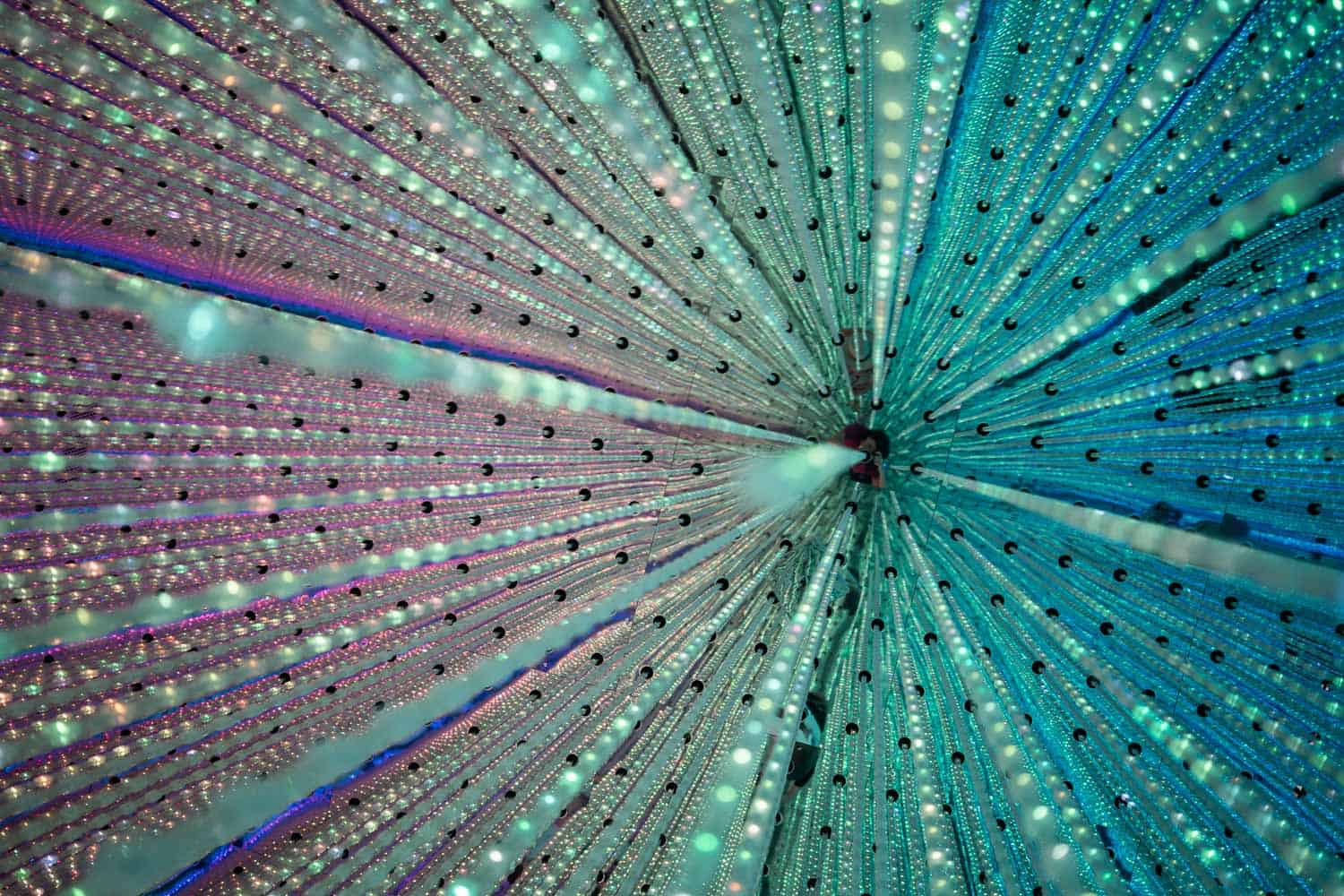
Strings of LED lights hang from the ceiling in this large room, the lights changing colour and the mirrored floor added to the feeling of infinite space.
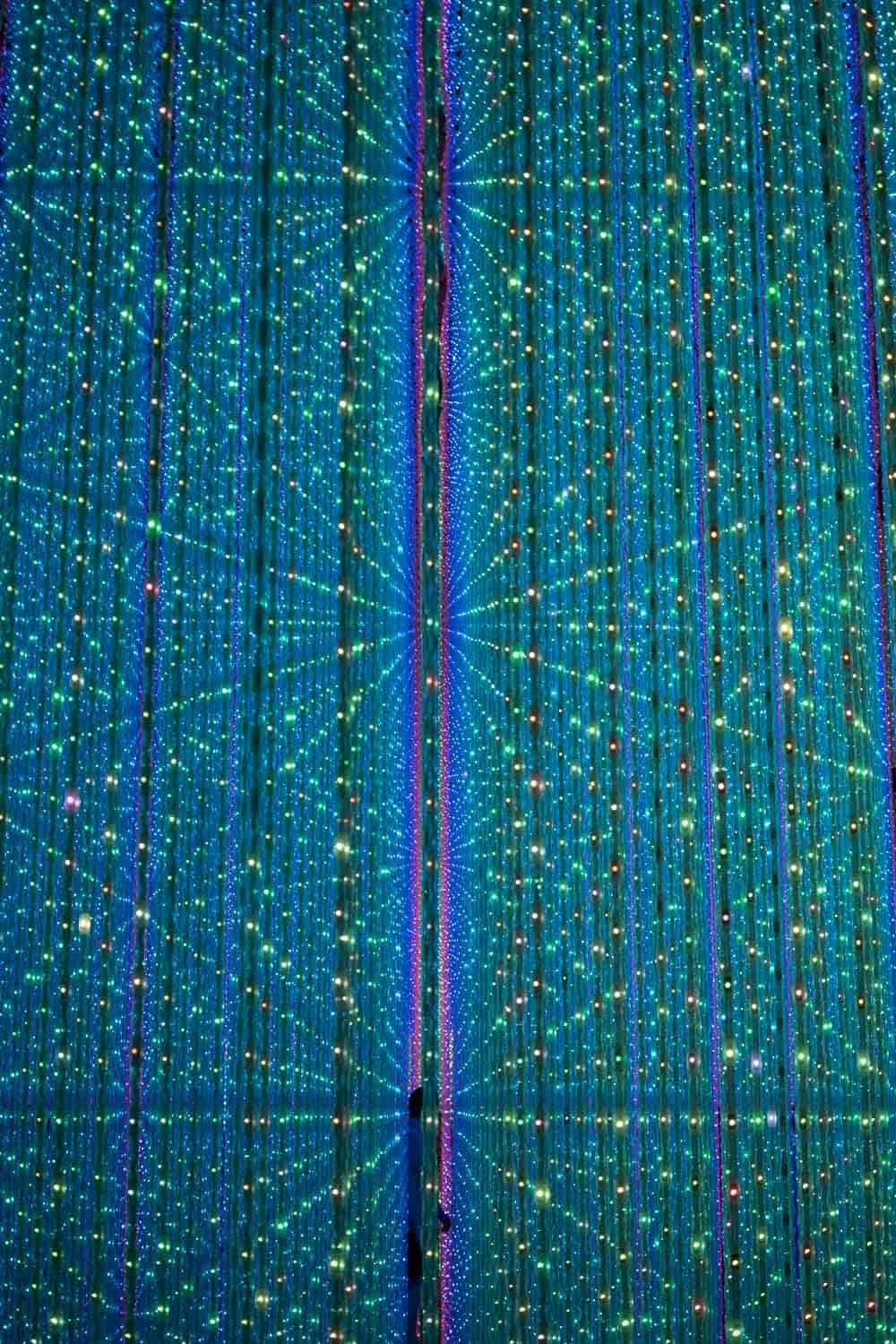
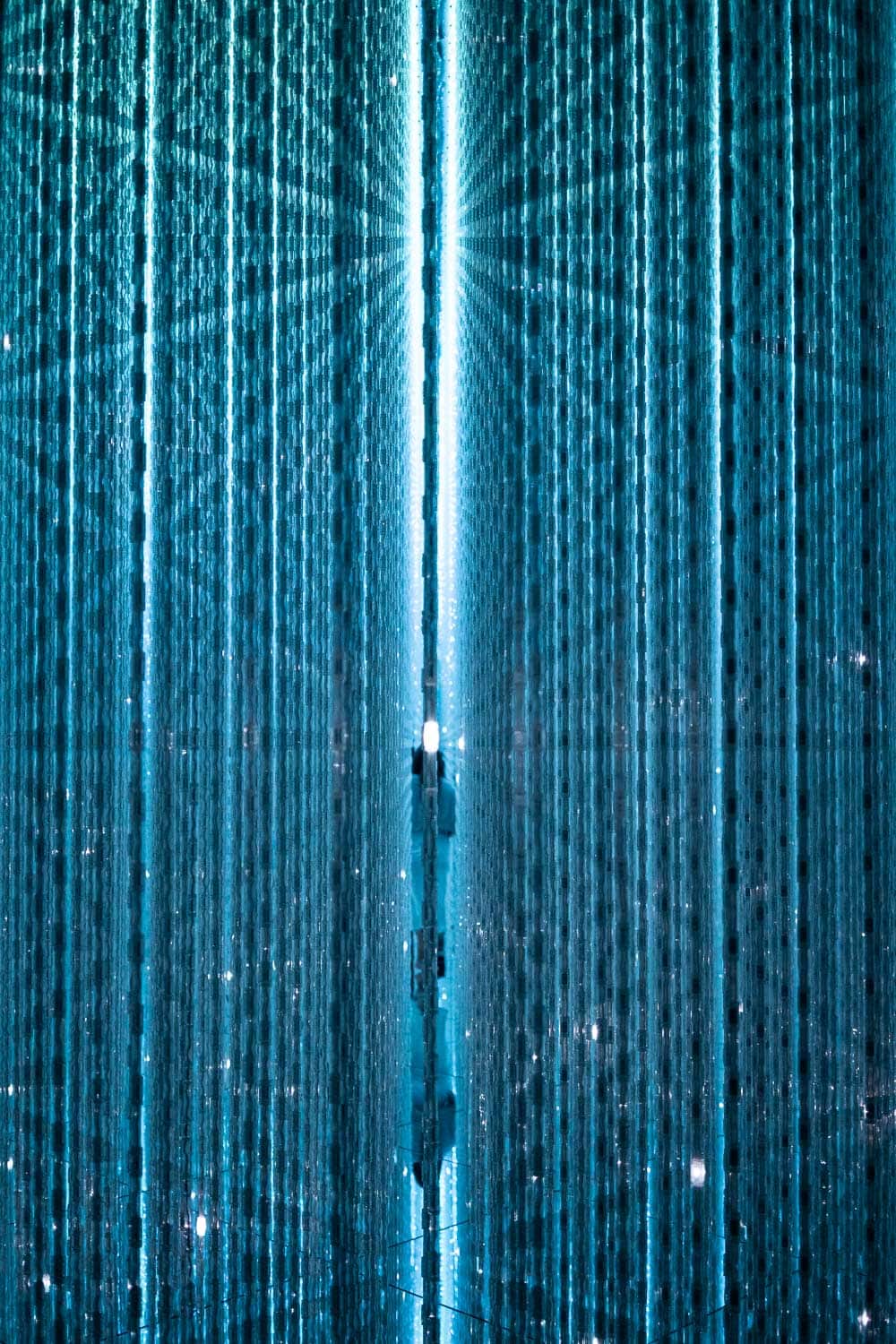
The TeamLab app allows you to participate in the art, but Simon couldn’t get it to work very well.
We loved exploring this surreal space.
The Koi Pond was next and another favourite. You walk across a dark room filled with warm water where projections of colourful koi fish swim across the water. When you collide with a fish, it transforms into a flower.
It’s not prerecorded or on a loop, so it’s never the same.
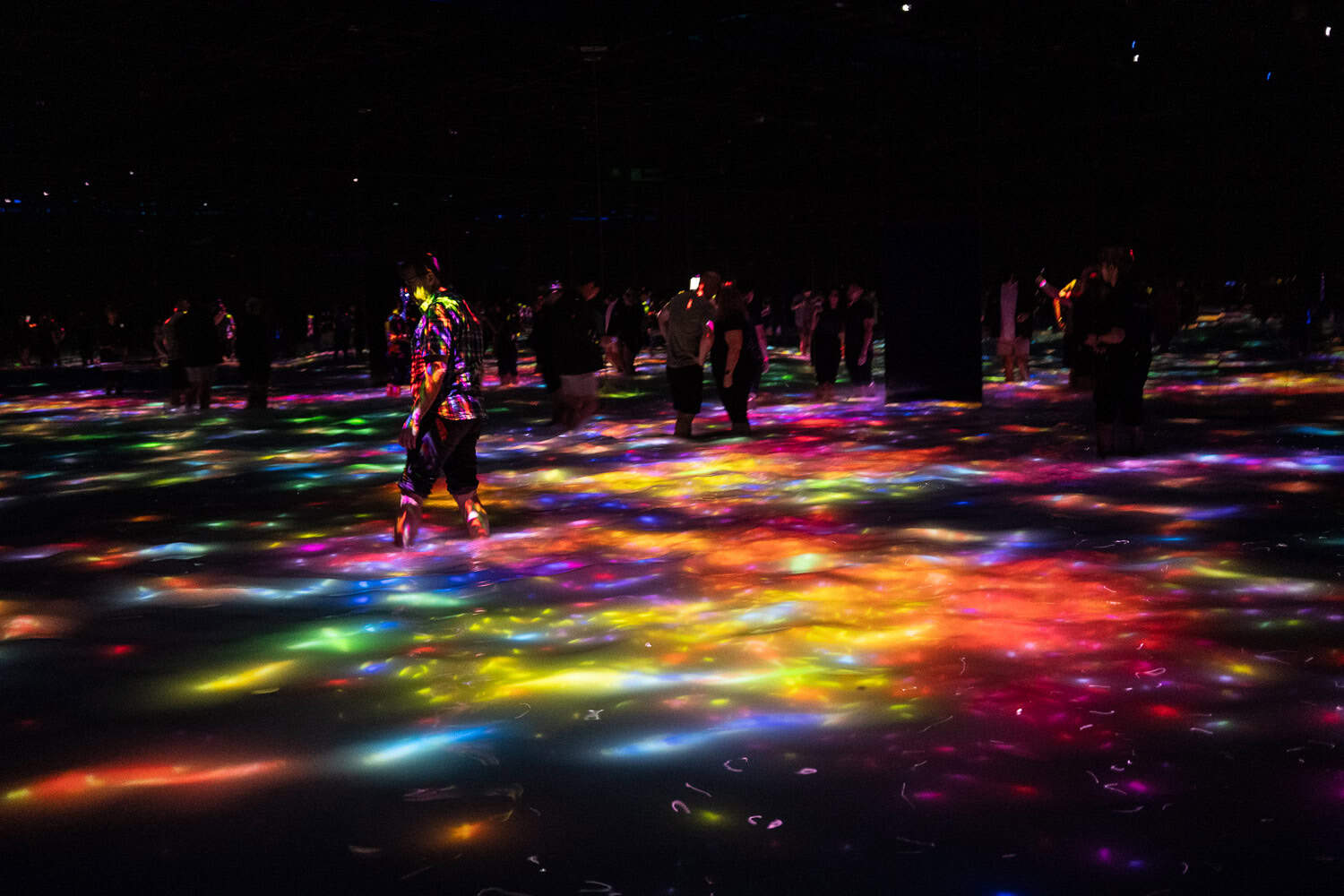
Don’t miss the side room off the pond called Ephemeral Solidified Light. Streams of water fall down, and as you put your hand near, the other streams go dark so you can conduct your own light show.
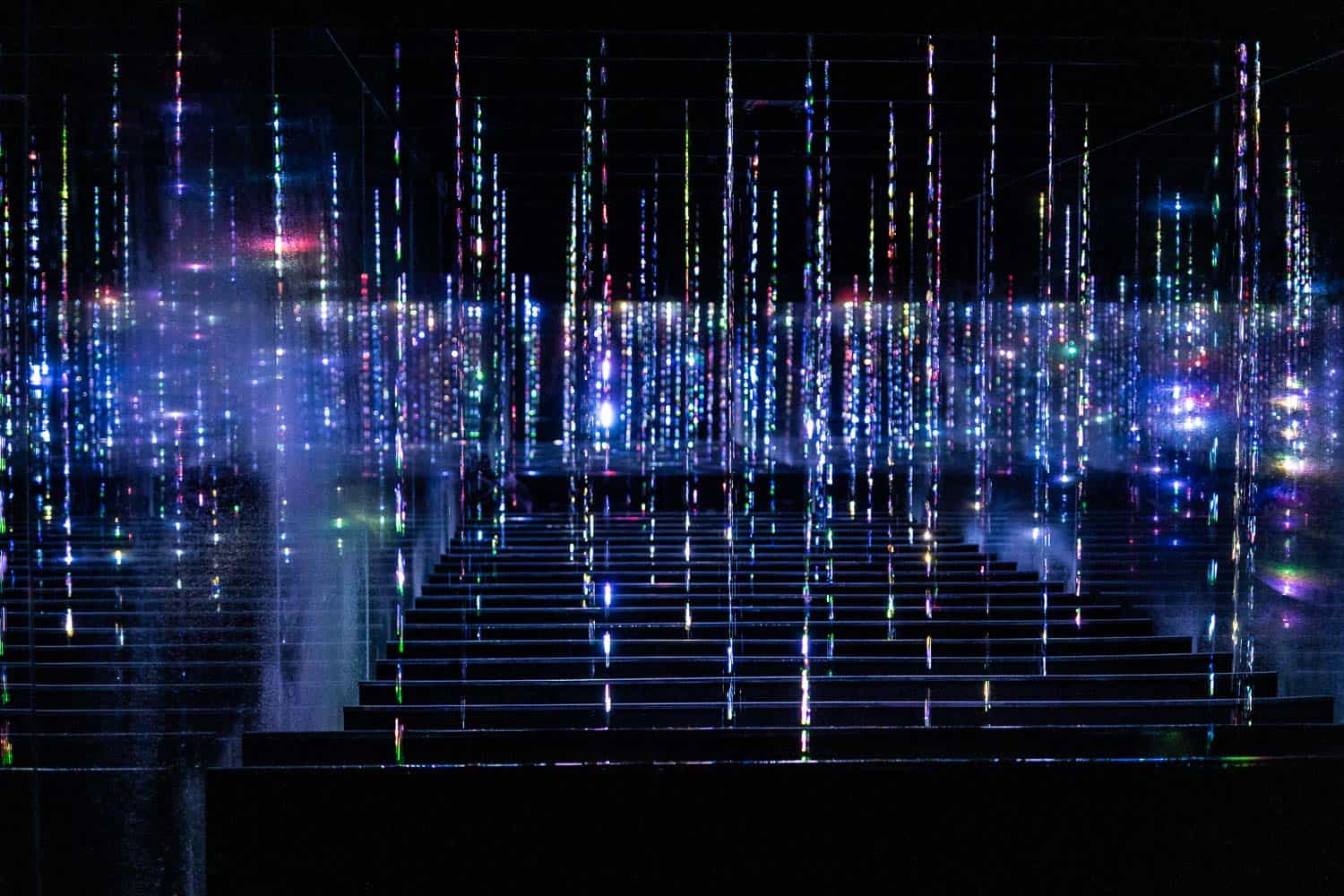
Back on dry land, we passed through a room of giant coloured spheres—when you touch the balls, they change colour and play a sound.
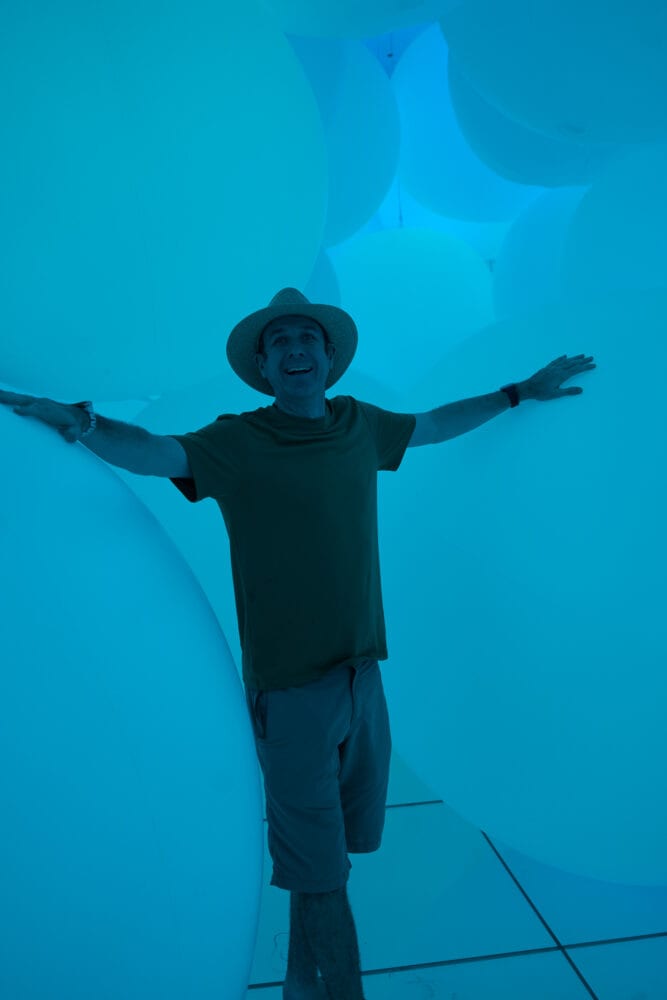
The final room on the Water side is Floating in the Falling Universe of Flowers. We loved how relaxing this one was (please be quiet to keep it that way!).
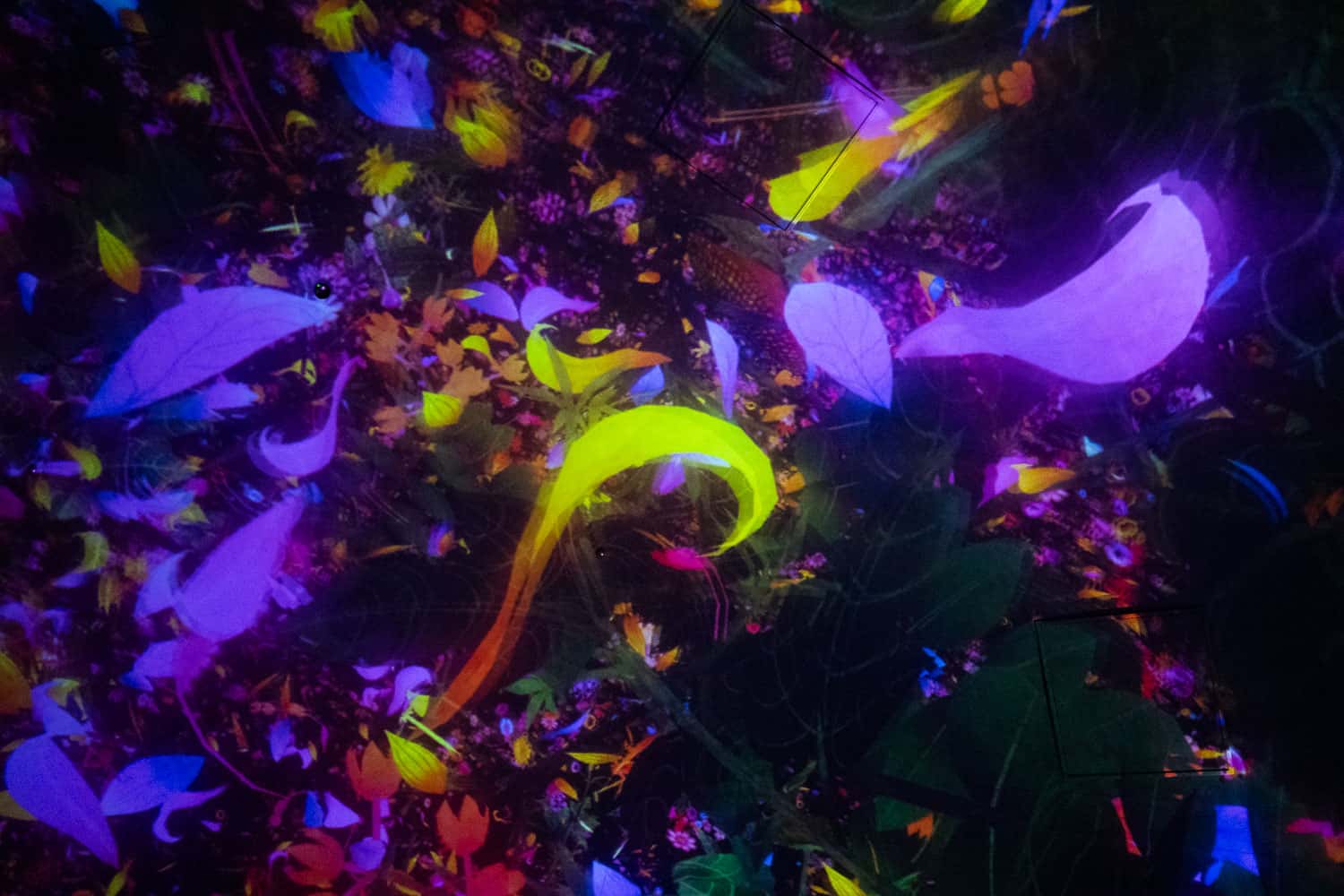
You sit or lie in the middle of the room and look up at the images of vibrant flowers projected on the walls and ceiling. They constantly change, and you see them bloom, wither, and die. There’s even a flower smell.
It’s quite a trippy experience, and it can feel like the floor is moving. Be careful as you stand up, as it’s disorientating.
Garden Area
We returned to the locker room before visiting the Garden side, which features two live gardens. This area is not projection-focused like Water, and it uses natural light.
The Moss Garden of Resonating Microcosms is outside—you are given sandals to wear. The small moss garden is full of reflective silver ovoids with mist rising between them.
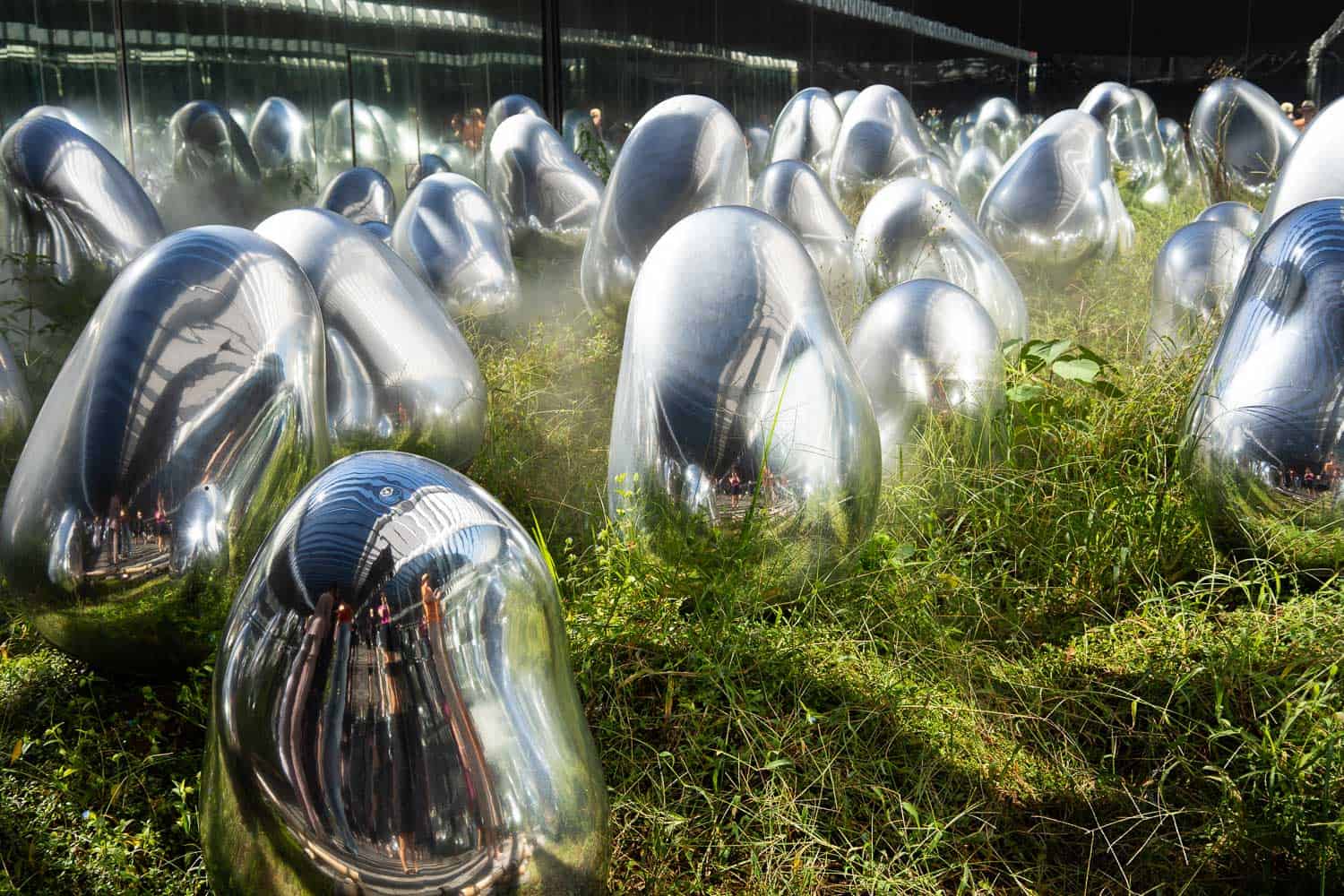
One of the advantages of visiting TeamLab Planets after sunset is seeing the ovoids glow in multiple colours. It looks very different after dark.
Finally, the Floating Flower Garden is the only exhibit that limits numbers and the time allowed inside, so we had to wait a short while to enter.
This is such a beautiful place with real orchids hanging from the ceiling and moving up and down so you can go underneath. The mirrored floor magnifies the effect.
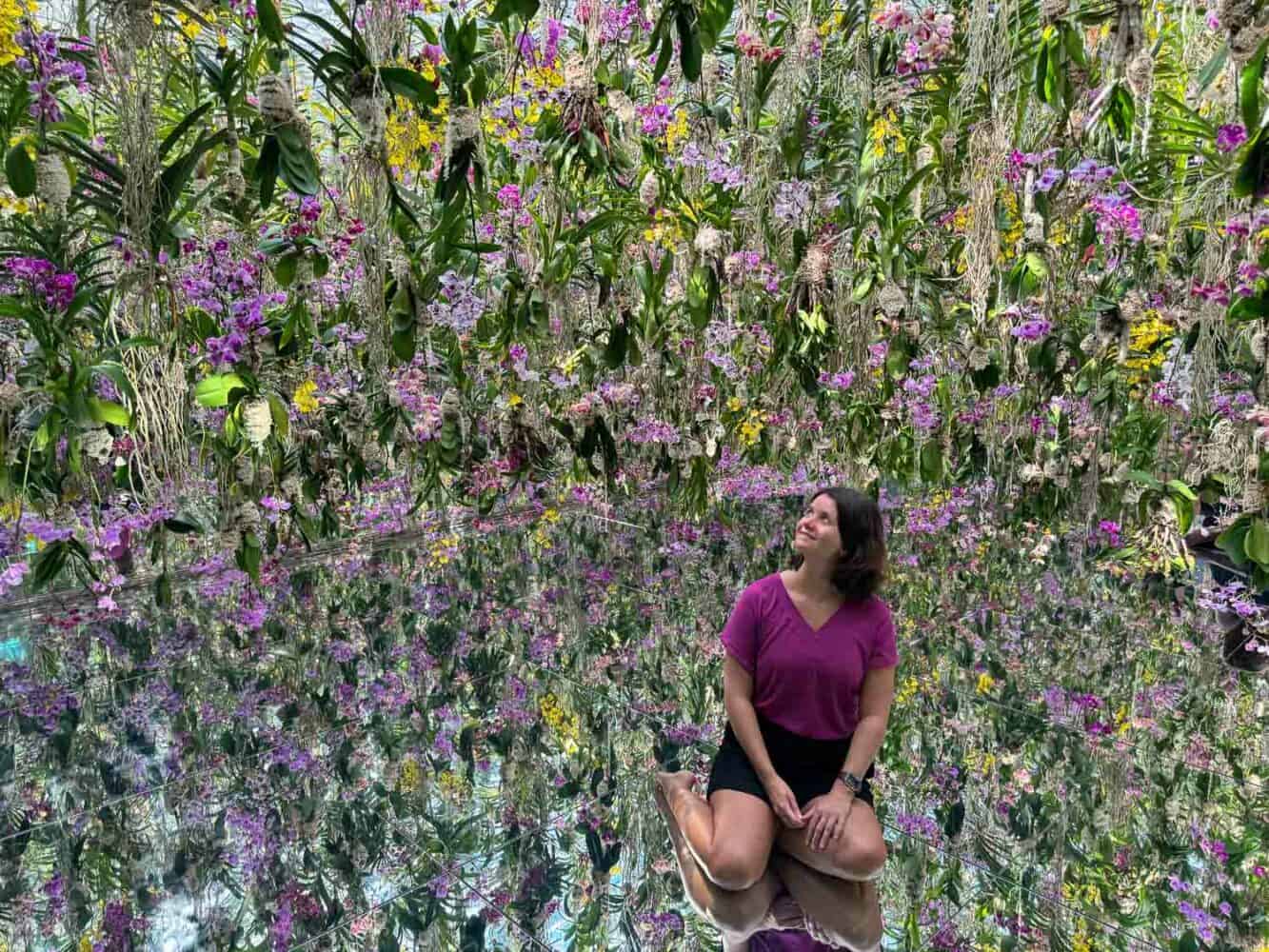
The exhibit is possible because the orchids can grow without soil by absorbing water from the air.
We loved our visit to TeamLab Planets so much that after returning to the locker room, we did another tour around the Water area. We didn’t take photos this time but immersed ourselves in the otherworldly atmosphere.
Forest: New in 2025
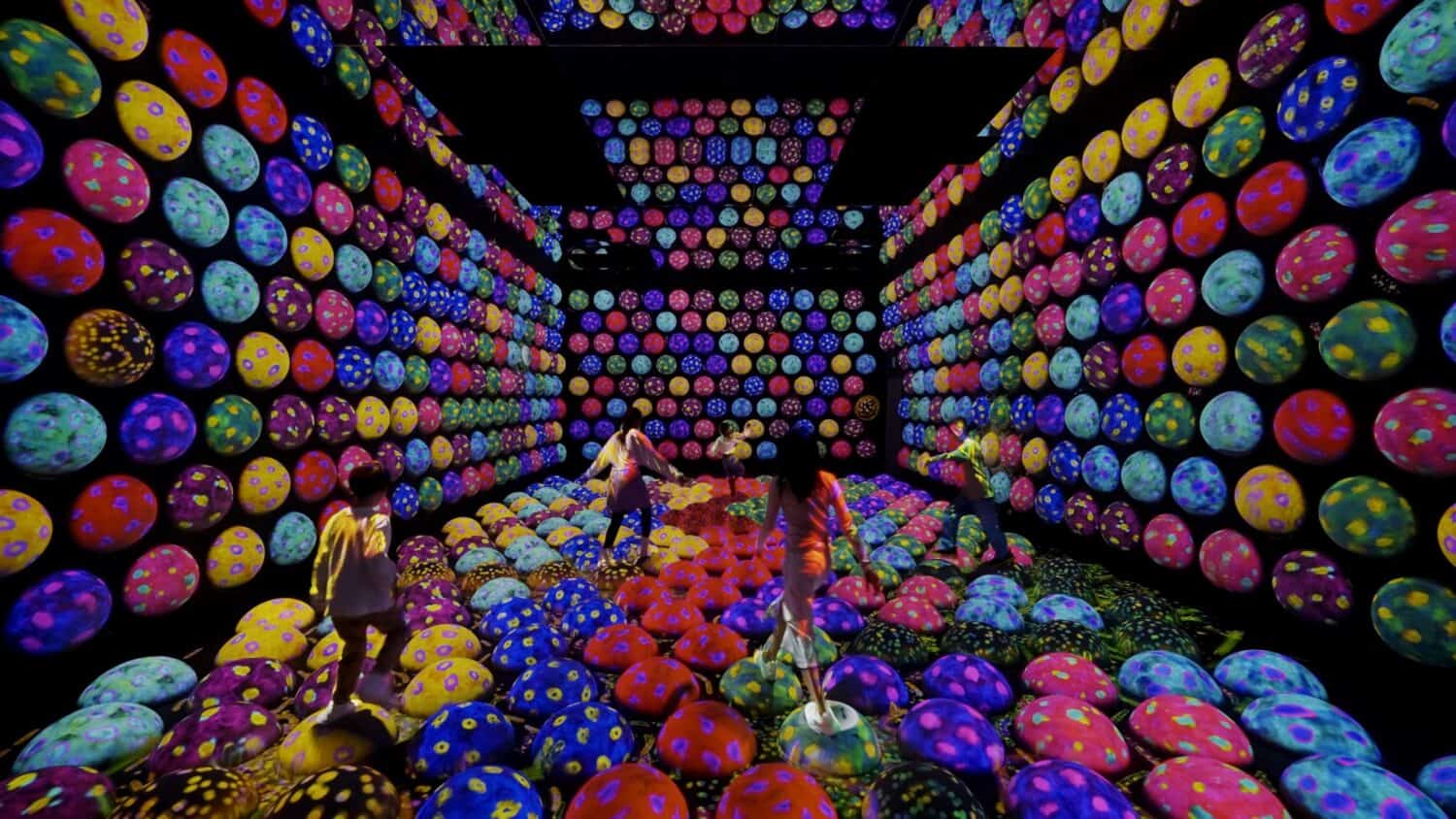
In January 2025, a huge new area called Forest opened with 20 artworks. We’re excited to visit next time!
It includes Athletics Forest, an interactive area where you challenge your body in three-dimensional spaces, jumping on spheres, climbing on bars amongst flocks of birds, and more. This is similar to the area from the original TeamLab Borderless (in the old location).
Catching and Collecting Extinct Forest is a beautiful space where you use your smartphone to catch and release extinct animals.
In Future Park you can sketch your own picture with a light pen or draw an animal and make it move using your phone.
The whole area is very child-friendly.
Another new space outside is Orchid Glass House, where you can drink tea and sake and watch orchids from Floating Flower Garden grow back after their flowers have fallen. It looks magical!
It’s for over 12s only and it only seats a few people, so be prepared to wait to get in.
What Are the Best Areas in TeamLab Planets?
Our favourite areas were Floating in the Falling Universe of Flowers, the Koi Pond, and the Floating Flower Garden (orchids).
UZU Ramen
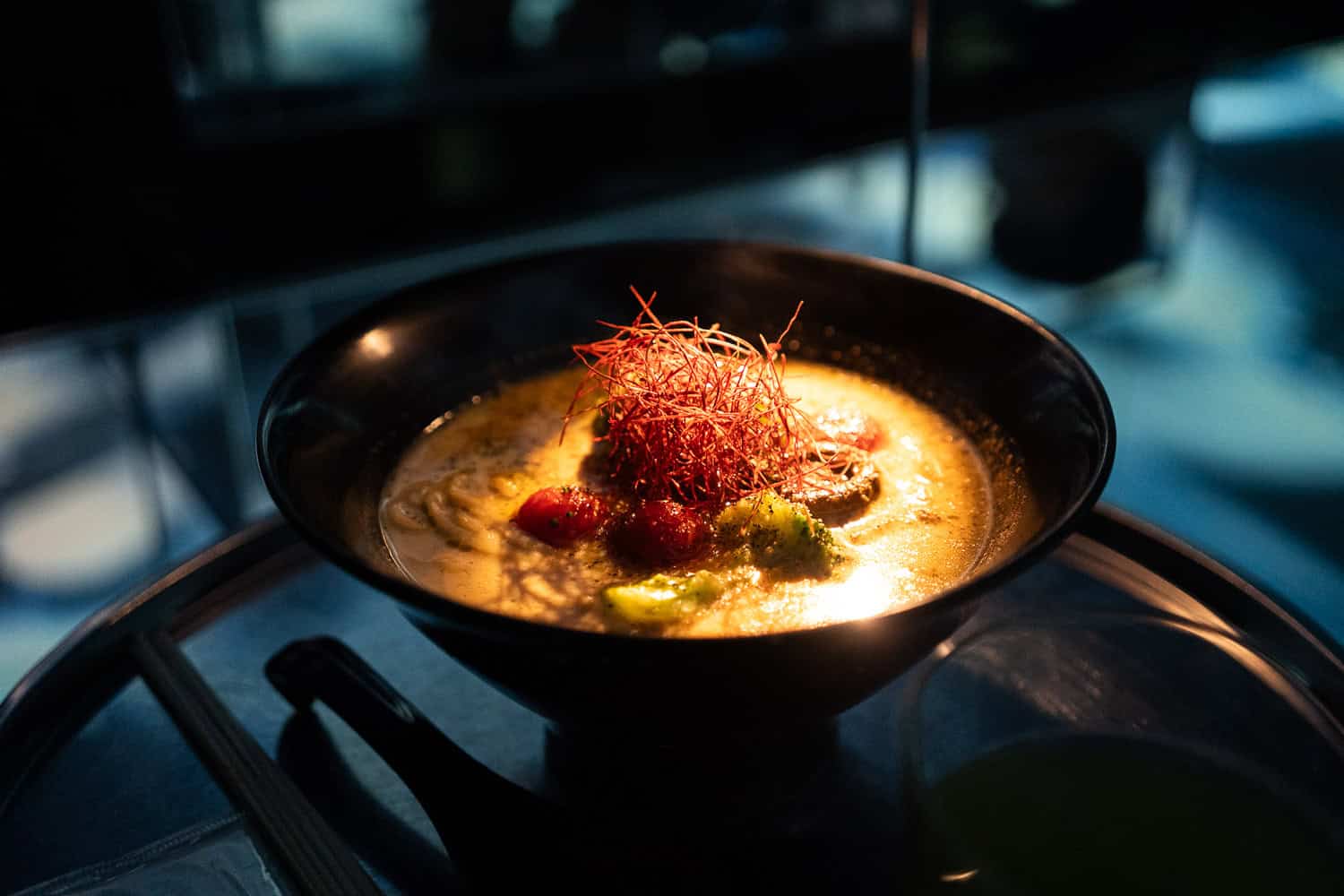
The fun doesn’t end once you leave the exhibit.
Outside TeamLab is our favourite ramen place in Tokyo—Vegan Ramen UZU. I highly recommend having a meal here after your visit (or before if visiting later).
You order at the counter and can eat at an outside table or pay extra for a set (which includes a drink) to be able to eat inside the art room, Black Emptiness Table.
There’s very limited space inside—only 10 people around a communal table—so you may have to wait.
Inside, it’s dark and cool, with projections on the ceiling and walls and reflected on the mirrored table. Everyone eating was quiet, so it made for a calming space.
There’s only one type of vegan ramen available, and it is delicious. The miso oat milk broth is flavourful, and the homemade noodles are pleasantly chewy.
You can also order drinks and vegan ice cream.
This is one of our favourite vegan restaurants in Tokyo. There’s also a branch in Kyoto that we recommend with more ramen choices and cool artwork—see our guide to vegetarian and vegan food in Kyoto.
How to Get to TeamLab Planets
TeamLab Planets can be reached by train and subway from across Tokyo. These are the nearest stations:
- Shin-Toyosu Station (Yurikamome Line) – 1 minute on foot.
- Toyosu Station (Yurakucho Line) – 10 minutes on foot (this is the most useful station).
- Shijoumae Station – 5 minutes on foot.
You can use Google Maps to find the best route from your hotel.
The downside of an early start slot at TeamLab is having to travel at rush hour—expect crowded trains. We left Shimokitazawa (near Shibuya) at 7.30am and had to stand the whole way (a one-hour journey with transfers).
Tokyo Station to TeamLab Planets
TeamLab Planets is easiest to reach from this side of Tokyo. Walk a few minutes to Yurakucho Station and take the Yurakucho Line directly to Toyosu Station (8 minutes) then walk 10 minutes.
Or take the JR Yamanote Line to Yurakucho (2 minutes) and change.
Shinjuku Station to TeamLab Planets
From Shinkuku Station, take the Shinjuku Line to Ichigaya Station, then switch to the Yurakucho Line to Toyosu Station. Allow about 45 minutes to one hour for the trip.
Ginza to TeamLab Planets
There’s a shuttle bus available between GINZA SIX and teamLab Planets. You can only buy the ticket on Klook.
What to Visit Near TeamLab Planets
Toyosu Market is a 5-10 minute walk from TeamLab Planets and is a popular destination for its fish market.
As vegetarians, we didn’t visit the market. Instead, we walked down to Toyosu Park on the way back to the station. On a sunny day, it was very pleasant with views of the canal. The open space felt good after being in more crowded parts of Tokyo.
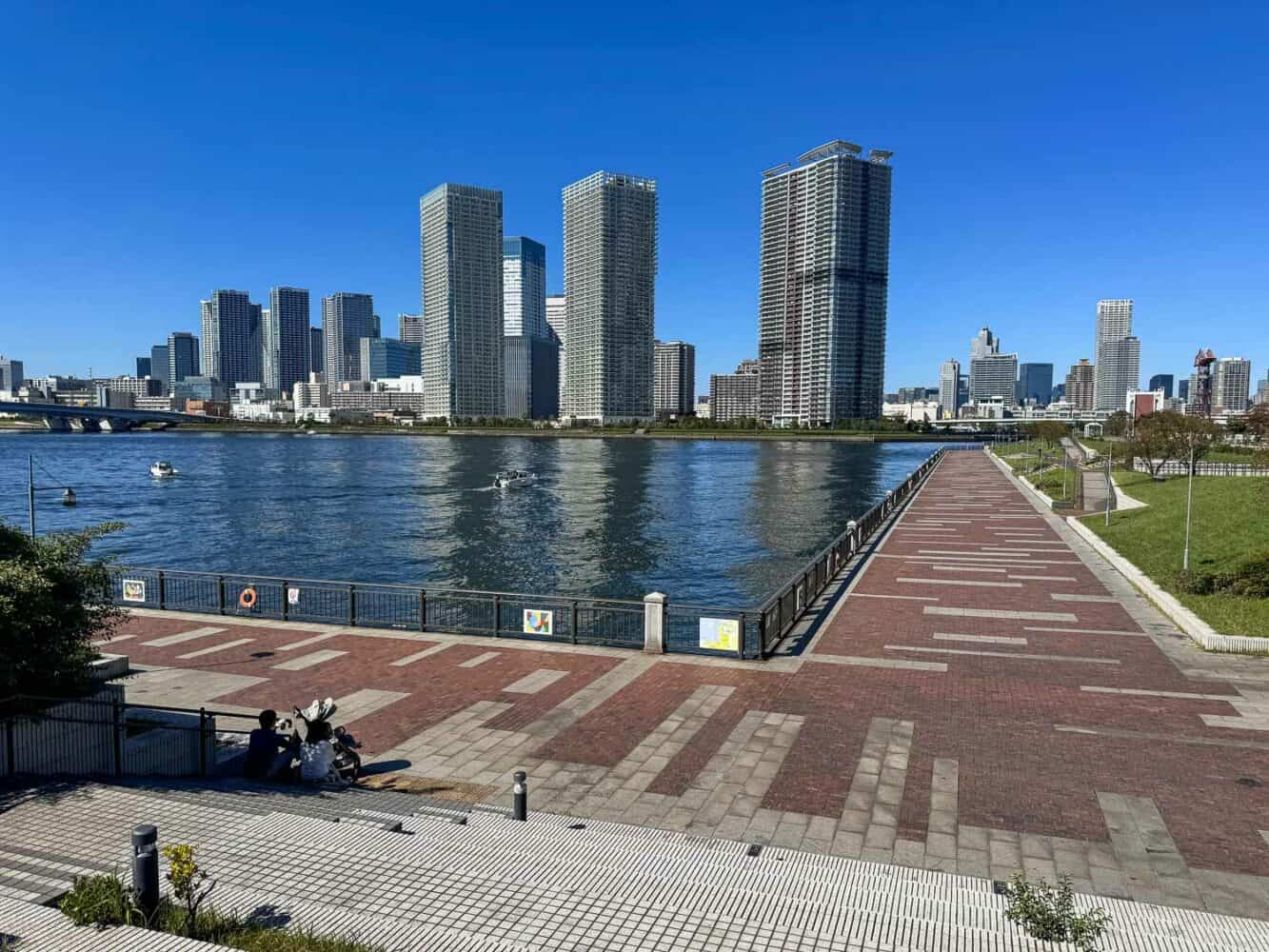
TeamLab Planets vs Borderless
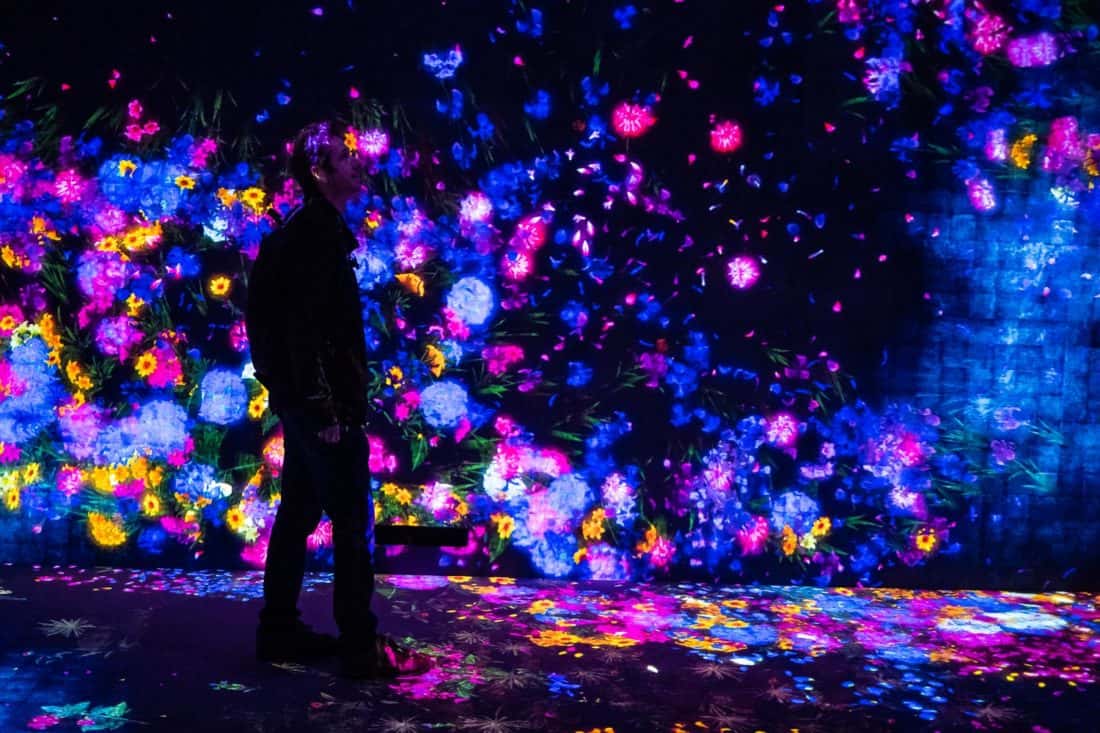
Are you wondering whether to visit TeamLab Planets or TeamLab Borderless?
Firstly, know that they are both stunning exhibitions with a similar style, and you can’t go wrong with either.
We visited Borderless at the previous Odaiba location (before it reopened in 2024) and loved it. Choosing between them is difficult. Here are a few differences:
TeamLab Planets
- Takes 1 hour+
- You go barefoot and walk through water.
- More tactile and physically immersive.
- You follow a designated path.
- Includes gardens with live plants.
- Uzu Vegan Ramen for food.
- Due to close at the end of 2027.
TeamLab Borderless
- More central location (Azabudai Hills near Roppongi).
- Much larger.
- Takes 2 hours+
- No fixed route through the exhibits.
- More spaces that you have to queue for.
- En Tea House for drinks.
- Slightly more expensive.
- Sells out faster.
- Permanent.
You can buy tickets to TeamLab Borderless on the TeamLab website or from Klook (sometimes with a discount).
Most people say that the new TeamLab Borderless is the better exhibition. It’s certainly much larger and more expansive. And some people prefer not having to take their shoes off.
That said, we loved the water and live plant elements of Planets (and, of course, the delicious ramen).
If you can, do both, but do Planets first.
Is TeamLab Planets Worth It?
Yes, TeamLab Planets is definitely worth visiting! It’s one of our favourite things to do in Tokyo.
We love how creative, colourful, and interactive the exhibition is. While it is great for photo ops (despite lighting challenges), we found it even more magical when we did a second loop without taking photos. It’s a place that lifts our spirits.
The price is reasonable for the quality of the exhibition, and while it is a bit out of the way, I think it’s worth the effort to get there.
More Japan Posts
Read more of our travel tips for Tokyo and elsewhere in Japan.
Our Tokyo Travel Guides
- 26 Cool Things to Do in Tokyo
- 18 Best Things to Do in Shinjuku, Tokyo
- 18 Best Vegetarian Restaurants in Tokyo
- Robot Restaurant: The Most Insane Show in Tokyo
- 14 Best Tokyo DisneySea Rides for Adults
- 14 Best Tokyo Disneyland Rides for Adults
Elsewhere in Japan
- Planning a Trip to Japan: Dos and Don’ts
- 56 Best Things to Do in Japan for an Unforgettable Trip
- Two Weeks in Japan: A Detailed Itinerary
- Ghibli Park Review
If you enjoyed this post, pin it!
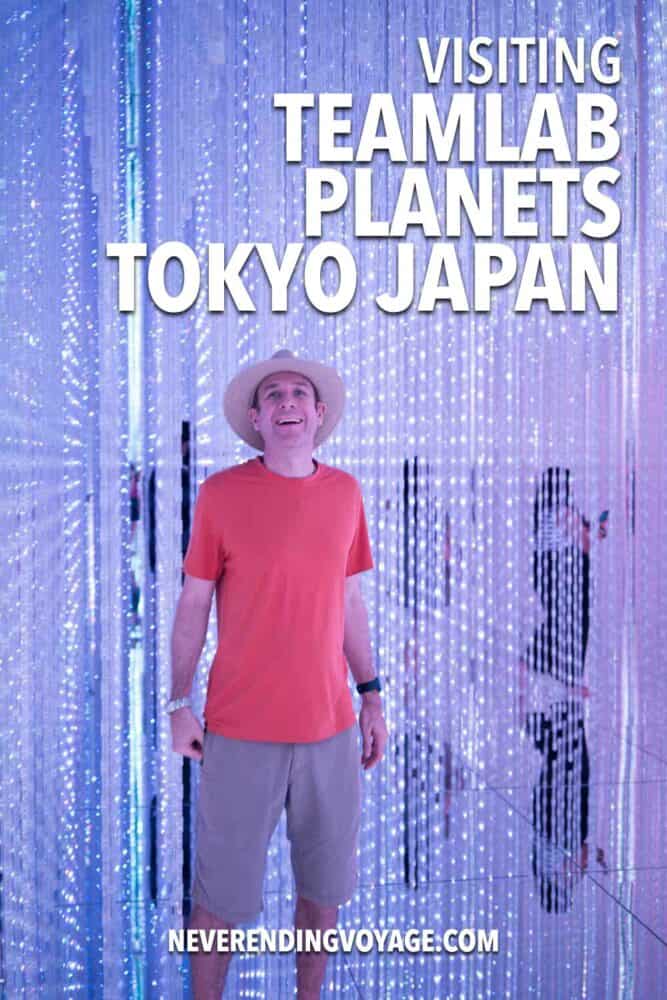
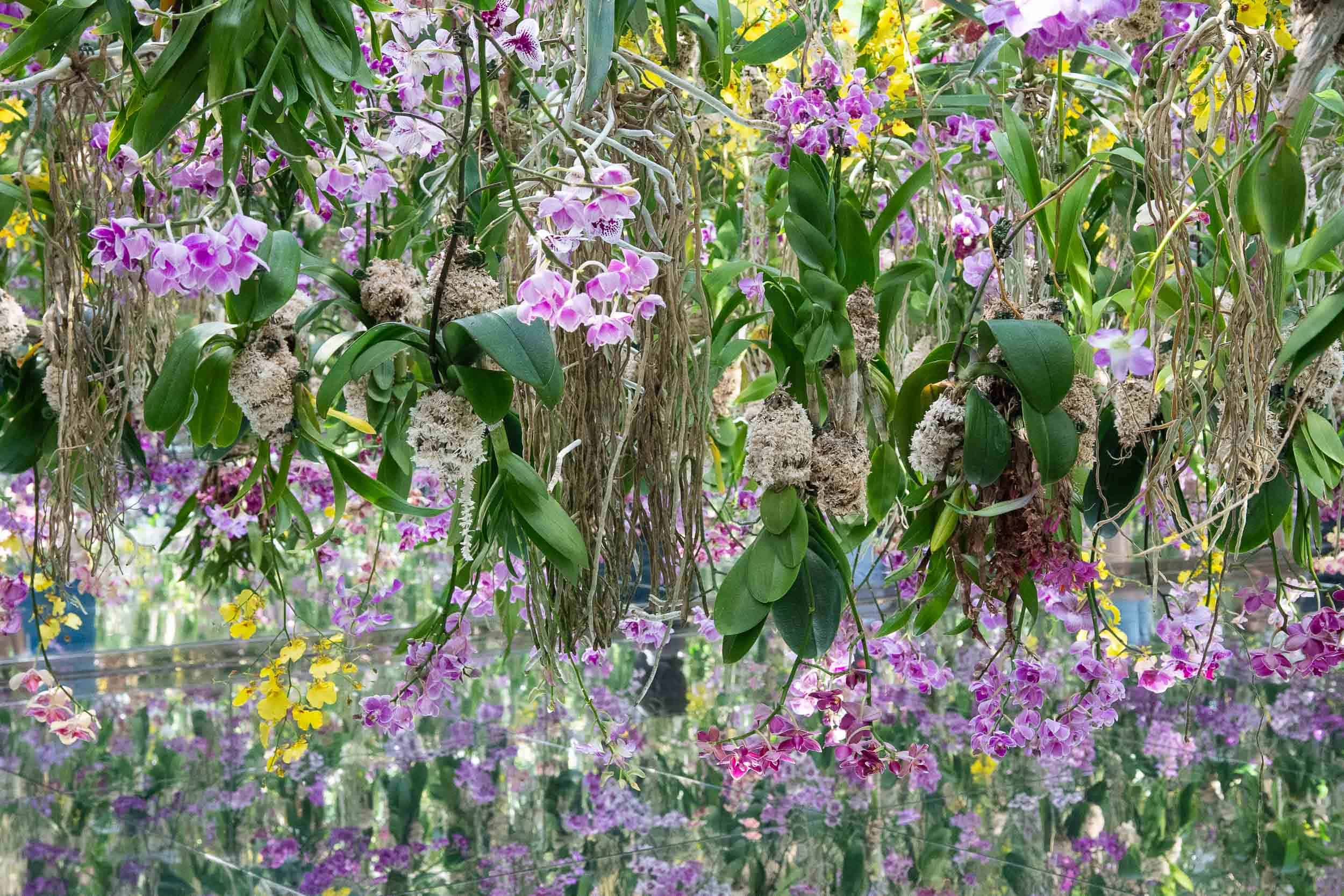
Hi there,
Thank you for such a detailed and insightful blog post! My husband and I are planning to visit next month and have also managed so secure the earliest timeslot.
We’d love to also try the vegan Ramen Place—may I ask how long you had to queue and wait for your food after teamlabs?
Thank you! :)
The ramen is so good! We got there at about 10.40am and queued for 5 minutes to order. We requested the table inside (with the artwork) and had to wait another 5 minutes to be seated there and then got our food 5 minutes after that, so about 15 minutes in total. It may be busier in April though (we were there mid-October). Enjoy!